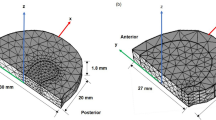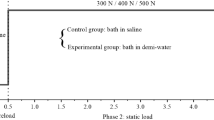Abstract
A new method for measuring the fixed charge density (FCD) in intervertebral disc (IVD) tissues employing a two-point electrical conductivity approach was developed. In this technique, the tissue is first confined and equilibrated in a potassium chloride (KCl) solution, and the tissue conductivity is then measured. This is then repeated with a second concentration of KCl solution. The FCD can be determined from the conductivity measurements. Using this method, the FCD values of bovine annulus fibrosus (AF) and nucleus pulposus (NP) tissues were determined to be 0.060 ± 0.027 mEq/g wet tissue and 0.19 ± 0.039 mEq/g wet tissue, respectively. The FCD of AF was significantly lower than that of NP tissue, similar to results in the literature for human IVD tissues. In order to verify the accuracy of the new method, the glycosaminoglycan (GAG) contents of the tissues were measured and used to estimate the tissue FCD. A strong correlation (R 2 = 0.84–0.87) was found to exist between FCD values measured and those estimated from GAG contents, indicating that the conductivity approach is a reliable technique for measuring the FCD of IVD tissues.




Similar content being viewed by others
References
Bashir, A., M. L. Gray, J. Hartke, et al. Nondestructive imaging of human cartilage glycosaminoglycan concentration by MRI. Magn. Reson. Med. 41:857–865, 1999.
Beckstein, J. C., S. Sen, T. P. Schaer, et al. Comparison of animal discs used in disc research to human lumbar disc. Spine 33:E166–E173, 2008.
Berkenblit, S. I., E. H. Frank, E. P. Salant, et al. Nondestructive detection of cartilage degeneration using electromechanical surface spectroscopy. J. Biomech. Eng. 116:384–392, 1994.
Buckwalter, J. A. Aging and degeneration of the human intervertebral disc. Spine 20:1307–1314, 1995.
Burstein, D., M. L. Gray, A. L. Hartman, et al. Diffusion of small solutes in cartilage as measured by nuclear magnetic resonance (NMR) spectroscopy and imaging. J. Orthop. Res. 11:465–478, 1993.
Chen, S. S., Y. H. Falcovitz, R. Schneiderman, et al. Depth-dependent compressive properties of normal aged human femoral head articular cartilage: relationship to fixed charge density. Osteoarthr. Cartil. 9:561–569, 2001.
Chen, C. T., K. W. Fishbein, P. A. Torzilli, et al. Matrix fixed-charge density as determined by magnetic resonance microscopy of bioreactor-derived hyaline cartilage correlates with biochemical and biomechanical properties. Arthr. Rheum. 48:1047–1056, 2003.
Eisenberg, S. R., and A. J. Grodzinsky. Swelling of articular cartilage and other connective tissues: electromechanochemical forces. J. Orthop. Res. 3:148–159, 1985.
Eyre, D. R., P. Benya, and J. Buckwalter. Intervertebral disk: basic science perspectives. In: New Perspectives on Low Back Pain, edited by J. W. Frymoyer, S. L. Gordon, et al. Park Ridge, IL: American Academy of Orthopaedic Surgeons, 1989, pp. 147–207.
Farndale, R. W., C. A. Sayers, and A. J. Barrett. A direct spectrophotometric microassay for sulfated glycosaminoglycans in cartilage cultures. Connect. Tissue Res. 9:247–248, 1982.
Frank, E. H., A. J. Grodzinsky, T. J. Koob, et al. Streaming potentials: a sensitive index of enzymatic degradation in articular cartilage. J. Orthop. Res. 5:497–508, 1987.
Gu, W. Y., and M. A. Justiz. Apparatus for measuring the swelling dependent electrical conductivity of charged hydrated soft tissues. J. Biomech. Eng. 124:790–793, 2002.
Gu, W. Y., M. A. Justiz, and H. Yao. Electrical conductivity of lumbar annulus fibrosis: effects of porosity and fixed charge density. Spine 27:2390–2395, 2002.
Gu, W. Y., W. M. Lai, and V. C. Mow. Theoretical basis for measurements of cartilage fixed-charge density using streaming current and electro-osmosis effects. ASME Adv. Bioeng. BED 26:55–58, 1993.
Gu, W. Y., B. Lewis, W. M. Lai, et al. A technique for measuring volume and true density of the solid matrix of cartilaginous tissues. Adv. Bioeng. ASME BED 33:89–90, 1996.
Gu, W. Y., B. Lewis, F. Saed-Nejad, et al. Hydration and true density of normal and PG-depleted bovine articular cartilage. Trans. Orthop. Res. Soc. 22:826, 1997.
Gu, W. Y., X. G. Mao, R. J. Foster, et al. The anisotropic hydraulic permeability of human lumbar anulus fibrosus. Influence of age, degeneration, direction, and water content. Spine 24:2449–2455, 1999.
Gu, W. Y., X. G. Mao, B. A. Rawlins, et al. Streaming potential of human lumbar anulus fibrosus is anisotropic and affected by disc degeneration. J. Biomech. 32:1177–1182, 1999.
Gu, W. Y., and H. Yao. Effects of hydration and fixed charge density on fluid transport in charged hydrated soft tissue. Ann. Biomed. Eng. 31:1162–1170, 2003.
Gu, W. Y., H. Yao, A. L. Vega, et al. Diffusivity of ions in agarose gels and intervertebral disc: Effect of porosity. Ann. Biomed. Eng. 32:1710–1717, 2004.
Guiot, B. H., and R. G. Fessler. Molecular biology of degenerative disc disease. Neurosurgery 47:1034–1040, 2000.
Hasegawa, I., S. Kuriki, S. Matsuno, et al. Dependence of electrical conductivity on fixed charge density in articular cartilage. Clin. Orthop. 177:283–288, 1983.
Helfferich, F. Ion Exchange. New York: McGraw Hill Book Company, Inc., 1962.
Hendry, N. G. C. The hydration of the nucleus pulposus and its relation to intervertebral disc derangement. J. Bone Joint. Surg. 40B:132–144, 1958.
Hickey, D. S., and D. W. L. Hukins. Relation between the structure of the annulus fibrosus and the function and failure of the intervertebral disc. Spine 5:106–116, 1980.
Iatridis, J. C., J. J. MacLean, M. O’Brien, et al. Measurement of proteoglycan and water content distribution in human lumbar intervertebral discs. Spine 32:1493–1497, 2007.
Insko, E. K., D. B. Clayton, and M. A. Elliott. In vivo sodium MR imaging of the intervertebral disk at 4 T. Acad. Radiol. 9:800–804, 2002.
Jackson, A. R., F. Travascio, and W. Y. Gu. Effect of mechanical loading on electrical conductivity in human intervertebral disk. J. Biomech. Eng. 131:054505, 2009.
Jackson, A. R., H. Yao, M. D. Brown, et al. Anisotropic ion diffusivity in intervertebral disc: an electrical conductivity approach. Spine 31:2783–2789, 2006.
Jackson, A. R., T. Y. Yuan, C. Y. Huang, et al. Effect of compression and anisotropy on the diffusion of glucose in annulus fibrosus. Spine 33:1–7, 2008.
Johnstone, B., J. P. Urban, S. Roberts, et al. The fluid content of the human intervertebral disc. Comparison between fluid content and swelling pressure profiles of discs removed at surgery and those taken postmortem. Spine 17:412–416, 1992.
Katchalsky, A., and P. F. Curran. Nonequilibrium Thermodynamics in Biophysics, Vol. 4. Cambridge, MA: Harvard University Press, 1975.
Kelsey, J. L., D. F. Mundt, and A. L. Golden. Epidemiology of low back pain. In: The Lumbar Spine and Back Pain, edited by J. I. V. Malcolm. New York: Churchill Livingstone, 1992, pp. 537–549.
Koneshan, S., J. C. Rasaiah, R. M. Lynden-Bell, et al. Solvent structure, dynamics, and ion mobility in aqueous solution at 25 C. J. Phys. Chem. 102:4193–4204, 1998.
Kraemer, J., D. Kolditz, and R. Gowin. Water and electrolyte content of human intervertebral discs under variable load. Spine 10:69–71, 1985.
Lai, W. M., J. S. Hou, and V. C. Mow. A triphasic theory for the swelling and deformation behaviors of articular cartilage. J. Biomech. Eng. 113:245–258, 1991.
Le, N. A., and B. C. Fleming. Measuring fixed charge density of goat articular cartilage using indentation methods and biochemical analysis. J. Biomech. 41:715–720, 2008.
Lesperance, L. M., M. L. Gray, and D. Burstein. Determination of fixed charge density in cartilage using nuclear magnetic resonance. J. Orthop. Res. 10:1–13, 1992.
Lu, X. L., C. Miller, F. H. Chen, et al. The generalized triphasic correspondence principle for simultaneous determination of the mechanical properties and proteoglycan content of articular cartilage by indentation. J. Biomech. 40:2434–2441, 2007.
Lu, X. L., D. D. Sun, X. E. Guo, et al. Indentation determined mechanoelectrochemical properties and fixed charge density of articular cartilage. Ann. Biomed. Eng. 32:370–379, 2004.
Lundon, K., and K. Bolton. Structure and function of the lumbar intervertebral disk in health, aging, and pathologic conditions. J. Orthop. Sports Phys. Ther. 31:291–303, 2001.
Marchand, F., and A. M. Ahmed. Investigation of the laminate structure of lumbar disc annulus fibrosus. Spine 15:402–410, 1990.
Maroudas, A. Physicochemical properties of cartilage in the light of ion exchange theory. Biophys. J. 8:575–595, 1968.
Maroudas, A. Biophysical chemistry of cartilaginous tissues with special reference to solute and fluid transport. Biorheology 12:233–248, 1975.
Maroudas, A. Physicochemical properties of articular cartilage. In: Adult Articular Cartilage, edited by Freeman MAR, Pitman Medical, London, 1979, pp. 215–290.
Maroudas, A., H. Muir, and J. Wingham. The correlation of fixed negative charge with glycosaminoglycan content of human articular cartilage. Biochim. Biophys. Acta 177:492–500, 1969.
Maroudas, A., and H. Thomas. A simple physicochemical micromethod for determining fixed anionic groups in connective tissue. Biochim. Biophys. Acta 215:214–216, 1975.
Maroudas, A., R. A. Stockwell, A. Nachemson, et al. Factors involved in the nutrition of the human lumbar intervertebral disc: cellularity and diffusion of glucose in vitro. J. Anat. 120:113–130, 1975.
Minassian, A., D. O’Hare, K. H. Parker, et al. Measurement of the charge properties of articular cartilage by an electrokinetic method. J. Orthop. Res. 16:720–725, 1998.
Narmoneva, D. A., J. Y. Wang, and L. A. Setton. A noncontacting method for material property determination for articular cartilage from osmotic loading. Biophys. J. 81:3066–3076, 2001.
NIH. Research on low back pain and common spinal disorders. NIH Guide 26, 1997.
Palmer, A. W., R. E. Guldberg, and M. E. Levenston. Analysis of cartilage matrix fixed charge density and three-dimensional morphology via contrast-enhanced microcomputed tomography. Proc. Natl. Acad. Sci. USA 103:19255–19260, 2006.
Panagiotacopulos, N. D., M. H. Pope, R. Bloch, et al. Water content in human intervertebral discs. Part II. Viscoelastic behavior. Spine 12:918–924, 1987.
Panagiotacopulos, N. D., M. H. Pope, M. H. Krag, et al. Water content in human intervertebral discs. Part I. Measurement by magnetic resonance imaging. Spine 12:912–917, 1987.
Perie, D., J. C. Iatridis, C. N. Demers, et al. Assessment of compressive modulus, hydraulic permeability and matrix content of trypsin-treated nucleus pulposus using quantitative MRI. J. Biomech. 39:1392–1400, 2006.
Shapiro, E. M., A. Borthakur, A. Gougoutas, et al. 23Na MRI accurately measures fixed charge density in articular cartilage. Magn. Reson. Med. 47:284–291, 2002.
Stevens, R. L., R. J. Ewins, P. A. Revell, et al. Proteoglycans of the intervertebral disc. Homology of structure with laryngeal proteoglycans. Biochem. J. 179:561–572, 1979.
Urban JPG. Fluid and solute transport in the intervertebral disc. PhD dissertation, London University, London, UK, 1977.
Urban, J. P. G., and A. Maroudas. The chemistry of the intervertebral disc in relation to its physiological function and requirements. Clin. Rheum. Dis. 6:51–77, 1980.
Urban, J. P., and A. Maroudas. Swelling of the intervertebral disc in vitro. Connect. Tissue Res. 9:1–10, 1981.
Urban, J. P., and J. F. McMullin. Swelling pressure of the intervertebral disc: influence of proteoglycan and collagen contents. Biorheology 22:145–157, 1985.
Wheaton, A. J., F. L. Casey, A. J. Gougoutas, et al. Correlation of T1rho with fixed charge density in cartilage. J. Magn. Reson. Imaging 20:519–525, 2004.
White, A. A. Biomechanics of lumbar spine and sacroiliac articulation: relevance to idiopathic low back pain. In: Symposium on Idiopathic Low Back Pain, edited by A.A. White and S.L. Gordon. St. Louis: CV Mosby Co., 1981, pp. 296–322.
Acknowledgment
This study was supported by the grant number AR050609 from NIH NIAMS.
Author information
Authors and Affiliations
Corresponding author
Rights and permissions
About this article
Cite this article
Jackson, A.R., Yuan, TY., Huang, CY. et al. A Conductivity Approach to Measuring Fixed Charge Density in Intervertebral Disc Tissue. Ann Biomed Eng 37, 2566–2573 (2009). https://doi.org/10.1007/s10439-009-9792-0
Received:
Accepted:
Published:
Issue Date:
DOI: https://doi.org/10.1007/s10439-009-9792-0




